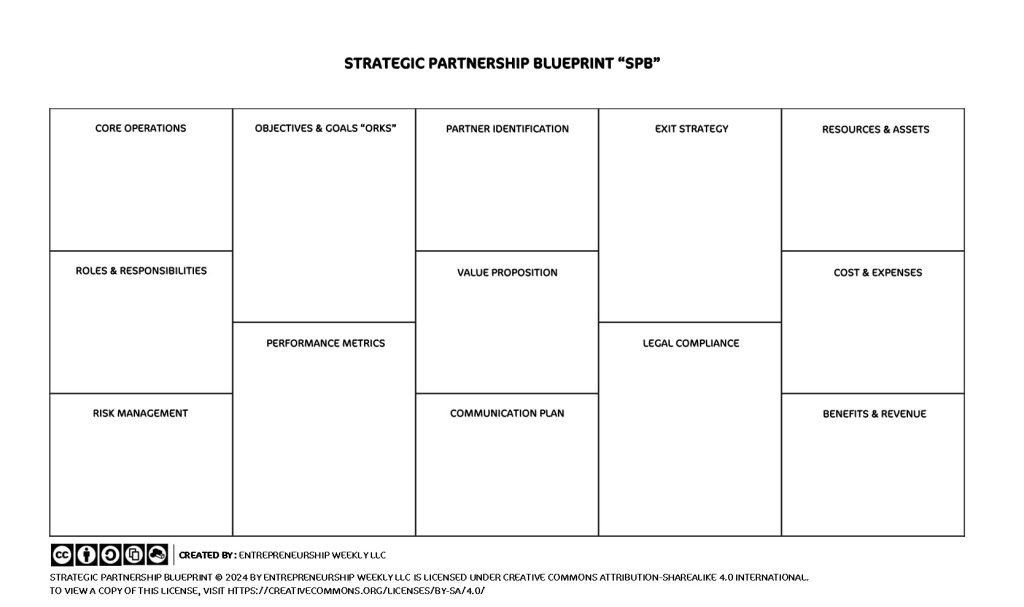
Strategic Partnership Blueprint © 2024 by Entrepreneurship Weekly LLC is licensed under Creative Commons Attribution-ShareAlike 4.0 International. To view a copy of this license, visit https://creativecommons.org/licenses/by-sa/4.0/
Strategic Partnership Blueprint Overview
The Strategic Partnership Blueprint is a comprehensive framework designed to help businesses and organizations build, manage, and optimize partnerships effectively. It serves as a practical guide for establishing strong collaborations, aligning mutual goals, and ensuring long-term success in strategic alliances.
This blueprint breaks down the essential elements of a partnership into easy-to-navigate sections, allowing both parties to clearly define expectations, share resources, and measure performance. Whether you’re entering a new partnership or enhancing an existing one, the Strategic Partnership Blueprint ensures that all key factors are considered to minimize risks and maximize mutual benefits.
Key Components of the Strategic Partnership Blueprint:
- Core Operations
Defines the primary activities that both partners will engage in. This includes the essential tasks and processes needed to make the partnership function smoothly and achieve its objectives. - Roles and Responsibilities
Clearly outlines the roles each partner will play and their specific duties within the collaboration. This ensures accountability and eliminates confusion about who is responsible for what. - Risk Management
Identifies potential risks within the partnership and establishes strategies for mitigating them. Both partners agree on how to handle uncertainties and safeguard their interests. - Objectives and Goals
Aligns the partnership’s mission by setting common goals. This ensures that both parties are working towards the same outcomes and share a clear vision of success. - Performance Metrics
Defines how the partnership’s success will be measured. Both quantitative and qualitative metrics are identified to track performance over time and ensure that the partnership remains beneficial. - Partner Identification
Involves the process of selecting the right partners based on mutual goals, values, and the complementary strengths they bring to the collaboration. - Communication Plan
Establishes the communication protocols between partners. Regular updates, meeting schedules, and reporting structures are put in place to ensure transparency and continuous dialogue. - Exit Strategy
Provides a clear process for dissolving the partnership if necessary. This includes agreed-upon terms for an orderly exit, should the collaboration no longer serve its purpose. - Legal Compliance
Ensures that both partners are adhering to any legal or regulatory requirements. Legal agreements are clearly defined to protect both parties and avoid legal disputes. - Resources and Assets
Identifies the resources, tools, or assets that each partner will contribute. This could include finances, technology, intellectual property, or expertise shared to achieve common objectives. - Cost and Expenses
Clearly defines how costs will be split and managed. Both partners agree on budgeting, financial commitments, and expense-sharing to avoid financial disagreements. - Benefits and Revenue
Outlines the revenue-sharing model and the benefits each partner stands to gain. This ensures that both parties are rewarded fairly based on their contributions to the partnership. - Value Proposition
Clarifies the value each partner provides to the other and to the collaboration as a whole. The unique benefits and competitive advantages the partnership brings are highlighted and agreed upon.
Why Use the Strategic Partnership Blueprint?
The Strategic Partnership Blueprint simplifies the complexities of managing partnerships by breaking them into manageable, actionable steps. It provides clarity from the outset, reduces misunderstandings, and ensures that both parties are aligned on goals and expectations. By following this blueprint, businesses can forge successful, lasting partnerships that drive growth, innovation, and mutual benefit.
Implementing the Strategic Partnership Blueprint
Step-by-Step Guide
- Initiate Partnership Discussions Begin by identifying potential partners and initiating discussions. Use the Partner Identification block to evaluate compatibility, shared values, and mutual benefits.
- Define Core Operations Clearly outline the Core Operations that will drive the partnership. Establish the key activities and processes that each partner will be responsible for.
- Allocate Roles and Responsibilities Assign specific roles and responsibilities to each partner. Ensure that everyone understands their duties and how they contribute to the partnership’s objectives.
- Develop a Risk Management Plan Collaborate on identifying potential risks and create a comprehensive Risk Management plan. Establish procedures for addressing and mitigating these risks.
- Set Objectives and Goals Agree on the Objectives and Goals that will guide the partnership. Make sure these goals are SMART (Specific, Measurable, Achievable, Relevant, and Time-bound).
- Establish Performance Metrics Define the Performance Metrics to track progress and measure success. Use both quantitative and qualitative indicators to assess how well the partnership is performing.
- Create a Communication Plan Develop a Communication Plan to facilitate ongoing dialogue between partners. Establish regular meetings, reporting structures, and methods for sharing information.
- Formulate an Exit Strategy Prepare an Exit Strategy outlining the process for dissolving the partnership if necessary. Ensure that terms for termination are fair and clearly defined.
- Ensure Legal Compliance Review and finalize all legal agreements to ensure Legal Compliance. This includes contracts, intellectual property rights, and regulatory requirements.
- Allocate Resources and Assets Identify and allocate Resources and Assets that each partner will contribute. This includes financial investments, technology, and other critical assets.
- Manage Costs and Expenses Agree on a budget and Cost and Expenses management plan. Ensure transparency in financial matters and establish procedures for expense reporting and reconciliation.
- Define Benefits and Revenue Sharing Outline the Benefits and Revenue sharing model. Agree on how profits and benefits will be distributed based on each partner’s contributions.
- Articulate the Value Proposition Clearly define the Value Proposition of the partnership. Highlight the unique value each partner brings and how it benefits both parties.
Best Practices for Using the Strategic Partnership Blueprint
- Regular Review and Adaptation: Periodically review the blueprint to ensure it remains relevant as the partnership evolves. Adapt strategies and processes as needed to address changing circumstances.
- Open Communication: Maintain open and transparent communication throughout the partnership. Regularly discuss progress, challenges, and any adjustments needed.
- Document Everything: Keep detailed records of agreements, decisions, and changes. Documentation helps prevent misunderstandings and provides a reference for future evaluations.
- Build Trust and Collaboration: Foster a culture of trust and collaboration. Effective partnerships thrive on mutual respect and a shared commitment to achieving common goals.
- Seek Expert Advice: Consult with legal, financial, and strategic experts as needed. Their insights can help navigate complex issues and ensure the partnership remains on track.
Conclusion
The Strategic Partnership Blueprint is an invaluable tool for businesses seeking to create and sustain successful partnerships. By following this framework, organizations can establish clear roles, manage risks, align goals, and ensure that both parties benefit from the collaboration. With careful planning and execution, the Strategic Partnership Blueprint can help drive growth, innovation, and long-term success for all involved.
